Namtok Phlio National Park
Contact Location : Namtok Phlio National Park 41 Moo 12, Phlio Sub-district, Laem Sing District, Chanthaburi Province 22190
Telephone Number : (+66) 3 943 4528 (VoIP) Fax: (+66) 3 943 4528 (VoIP)
Email : namtokphlio_np@hotmail.com
Facebook : Namtok Phlio National Park
Information
Namtok Phlio National Park covers Mueang District, Laem Sing District, Khlung District, and Makham District in Chanthaburi Province. It is a dense forest surrounded by a complex and high mountain range with numerous streams. The unique feature is the beautiful Namtok Phlio with water flowing all year round, well known by the general public. It is located about 14 kilometers from Chanthaburi downtown. The paved road running all the way to the waterfall makes it comfortable to visit on vacation. It has an area of approximately 134.50 square kilometers (84,062.50 rai)
Background
According to the Cabinet Resolution on October 7, 1959, Khao Sa Bap Forest, Chanthaburi Province, and other 14 forests in the area are established as national parks. Initially, the Royal Forest Department designated Namtok Phlio - Khao Sa Bap Forest as a National Reserved Forest in 1962, pursuant to the Forest Protection and Reservation Act of 1938 (B.E. 2481), dated February 6, 1961. In 1972, the Phlio Waterfall area was developed and established as Namtok Phlio Forest Park under the supervision of the office of Chanthaburi Provincial Forest.
The meeting of the National Park Committee No.1/2517 on January 22, 1974, decided to expedite the declaration of forest areas that the Cabinet approved on October 7, 1959, as National Parks. Chanthaburi province had an urgent letter Cho Bo No. 09/1401 dated January 31, 1974, requesting the Royal Forest Department to send officers to be stationed at Namtok Phlio National Park to improve the area in accordance with the forest park management principles. Additionally, in 1974, the National Park Division had a plan to establish the area as a national park. Therefore, on March 28, 1974, the Royal Forest Department issued an order No. 360/2517 dated March 28, 1974, asking Mr. Sinchai Buranarak, a Forestry Technical Officer, and Mr. Prachum Tanyabut, a Project Officer level 2, to survey the forest areas of Namtok Phlio and Khao Sa Bap in Chanthaburi Province. It appears that the area consists of folded complex mountains, which are the origin of various streams such as waterfalls, as well as cliffs, and caves, according to the survey report No. Ko So 0708 (O So)/7 dated June 28, 1974.
The Royal Forest Department proposed to the National Parks Committee, which was resolved in the meeting No.6/1974 on July 26, 1974, to define the area as a National Park by issuing a royal decree specifying the area of Namtok Phlio - Khao Sa Bap Forest in Phlapphla, Khlong Narai and Kom Bang Sub-district, Mueang Chanthaburi District, Phlio Sub-district, Laem Sing District, Makham Sub-district, Makham District, Map Phai, Wang Sapparot, Trok Nong, Sueng, Tapon and Kwian Hak Sub-district, Khlung District, Chanthaburi Province to be a National Park It was announced in the Government Gazette, Volume 92, Section 87, dated May 2, 1975, as the 11th national park in Thailand with the name "Khao Sa Bap National Park."
Later, Mr. Phajon Thanamitramanee, the superintendent of Khao Sa Bap National Park, issued a letter No. Ko So 0708 (So Bo)/special dated March 1, 1982, requesting that the name of Khao Sa Bap National Park be renamed Namtok Phlio National Park because Namtok Phlio is a waterfall with natural beauty that is the highlight of the national park. It has been known to visitors and the general public for a long time. The National Park Committee, resolved in meeting No. 3/1982 on September 29, 1982, approving the change of the name to "Namtok Phlio National Park."
Note : After paying the entrance fee to the National Park, please carry the receipt for inspection.
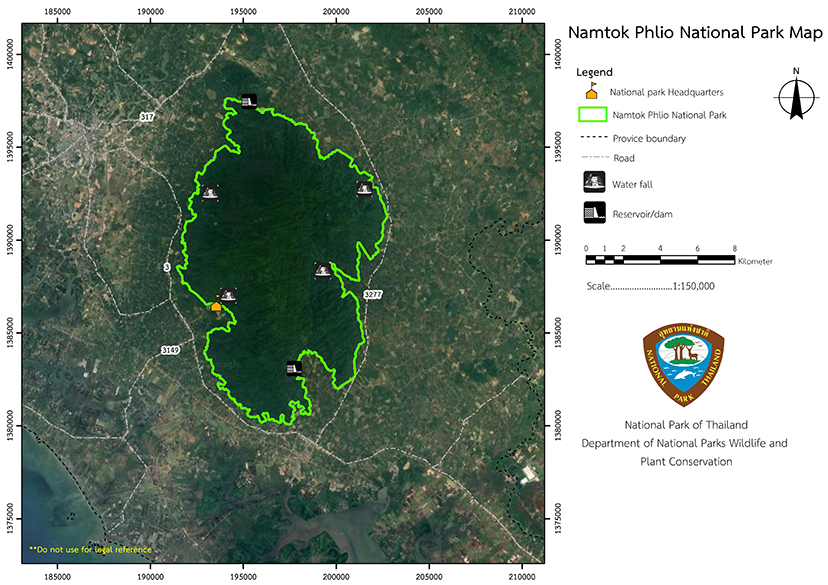
84,062.50 rai (134.5 square kilometers).
|
Khlong Narai Waterfall |
Trok Nong Waterfall |
||
|
Trok Nong Waterfall |
MagogWaterfall |
||
|
Kongsi Rai Reservoir |
Huai Tabo Reservoir |
||
Nature trails ⇔ Visit Waterfall ⇔ Observe flowers/plants ⇔ Bird/Butterfly ⇔ History/Culture
Welfare shop : (coffee, desserts, drinks) is open daily from 7:00 - 17:00 hrs.
Mobile phone signal :
1. National Park Headquarters: AIS, TRUE, DTAC
2. Tourist service areas: AIS, TRUE, DTAC
3. Accommodation areas: AIS, TRUE, DTAC
|
|
Namtok Phlio National Park area is primarily mountainous and complex high mountain ranges. It is in the range of 20 - 924 meters above sea level, gradually sloping down to the south, with narrow plain areas surrounding the mountainside. The site is on a steep slope. Khao Map Wa Krok Summit, at approximately 924 meters above sea level, is the highest point. The geological characteristics of the rocks are mostly igneous rocks of the granite type. In the middle of the area, terrain is steep complex mountains. It comprises pristine evergreen forests, which make this area a headwater of many small creeks with water flowing all year round, such as Khlong Narai, Khlong Phlio, Khlong Trok Nong, Khlong Makok, Khlong Suan, Khlong Khlung, scattered around. The central area is a steep ridge.
|
|
Namtok Phlio National Park is located in Chanthaburi Province, which is in the eastern part of Thailand. It is under the influence of monsoons, seasonal wind circulation system. The northeast monsoon is characterized by wind from the northeast, which originates in China. The duration is from November until February, causing a winter which is not very cold. The average temperature throughout the year is 26.8 degrees Celsius. The highest average temperature is 31.6 degrees Celsius, and the lowest average temperature is 23.2 degrees Celsius. Another monsoon from the southeast blowing from the ocean brings moisture and water vapor from the sea causing rainy season. The air is humid and it rains quite often. The annual rainfall averages more than 2,000 millimeters. From March to April, it's the summer which is sweltering before the monsoon transition and the next rainy season begins in May.
|
|
|
|
|
Flora and Wildlife *The second layer has much denser tree species than the upper one. The canopy cover is about 95 percent, while the upper is only 60 percent. The average height of the tree is about 19 meters, with more species diversity than that of the upper. Plant species found include Xerospermum Intermedium, Eagle Wood (Aquiloaria crassna), Helicia excelsa, long (Archidendron quocense), Prunus arborea Var.montana, and Santol (Sandoricum indicum). In total, there are 28 types. In addition, epiphytic plant species are also found around the trunks and branches of the trees consisting of Staghorn Fern, Oak-Leaf fern (Drynaria quercifolia), bird's-nest Fern, Hoya diversifolia Blume, Dischidia imbricata (Blume) Steud, and Orchidaceae family, especially Dendrobium friedericksianum Rchb.f, with beautiful shapes and bright colors (native to Chanthaburi). Another group of plants that are prominently important in the evergreen forest is the vine families, such as Snake Plant, Virginia Creeper, Chinese Salacia (Salacia chinensis), and rattan plants. *Understory is a layer that is less dense than the second layer, not higher than 5 meters. Typically, the plant species, of about 36 species, are seedlings and sprouts of the second-layer trees. Additionally, there are many kinds of undergrowth plants. The dense forest with multiple canopy layers contributes to soil covering, thereby reducing soil erosion, retaining moisture, and allowing water to be stored in the soil. Therefore, it has the potential to feed water into streams all year round. 2. This area has a rich biodiversity of wildlife. Namtok Phlio National Park area has a very abundant rainforest condition, but it is a flat area surrounded by asphalt roads and local highways. Moreover, this forest is not connected to other conservation forests, resulting in a solitary ecosystem of animals. There are many critically endangered endemic birds, such as Lewis' Silver Pheasant, as well as animals that are unique to the tropical rainforest, such as Pileated Gibbon. Additionally, there is one preserved wild animal according to the Wildlife Preservation and Protection Act B.E. 2535, that is Serow. Mammals found include in 9 orders, 22 families, and 38 species, of which 12 species are protected wildlife. The most common animals are rodents in the Rodentia order, which contains eight species, followed by bats in the Chiroptera order, with seven species. The most abundant species are carnivores, or predators, in the Carnivora order, according to the study report, which are 11 species, but only four species are directly found. Only four species of herbivores, or even-toed ungulates, are found in the Artiodactyla order. Four species of lemurs the Primate order are found in the direct survey. In addition, mammals with a small number of species per family and order are found, including Pangolin (Pholidota order, Manidae family), Dwarf shrew (Insectivora order, Soricidae family), Northern treeshrew (Scandentia order, Tupaiidae family), and Sunda Colugo (Dermoptera order, Cynocephalida family). Birds are found in a total of 15 orders, 43 families, and 149 species. They are mostly protected species under the Wildlife Preservation and Protection Act B.E. 2535. Passerine is the dominant order, accounting for more than half of all birds; the remaining 50% is made up of approximately 70 species. The order Piciformes has the greatest diversity with 13 species, and the families of Kingfisher, Blue-tailed Bee-Eater, Hornbill, and Indian Roller have 13 species. The minor groups of birds include 13 species of the family of Columbidae, six species of Hawks, and nine species of Owls and Pheasants. Additionally, Herons, King Quails, Parrots, and Nightjars are seen with 2 species each. Ducks, Swallows, and Red-billed blue magpies are found in only one species each. Reptiles are found in 2 orders, 13 families, and 59 species. Snakes (Squamata order, Serpentes suborder) have the most diverse population, with 27 species divided into 25 families. The second highest number of reptiles is in the Squamata order, the Sauria suborder, with 25 species from 5 families, such as Lizards, Geckos, Skinks, the Monitor Lizard in the Varanidae family, and the Lacertidae family. The final reptile order is the Chelonia order, which contains seven species divided into three families and includes Tortoises, Freshwater Turtles, and Softshell Turtles. The amphibians discovered comprise a total of 19 species from one order, five families, and 15 genera, including Frogs, Common Tree Frogs, Chubby Frogs, Bullfrogs, Asian toads, and freshwater fish. In Namtok Phlio National Park, there are water sources with water flowing all year round, consisting of reservoirs, streams, and waterfall basins that are suitable for marine animals, especially a variety of fish species, including Jullien's Mud Carp, Siamese Rock Catfish, River Loaches, Lizardfish, Soro Brook Carp, Gouramis, Trichopsis, Dwarf Snakehead, and Zig-zag eel. |
How to get there by car :
Visitors can take Bangkok - Trat route, turn left at the junction of the milestone No. 347th and continuing for about two kilometers to reach the Namtok Phlio National Park Headquarters. It is located 14 kilometers from Chanthaburi downtown and 55 kilometers from Trat downtown.
- National Park Ranger Station Pho Lo No. 1 (Namtok Trok Nong)
- National Park Ranger Station Pho Lo No. 2 (Ban Ang)
- National Park Ranger Station Pho Lo No. 3 (Namtok Khlong Narai)
- National Park Ranger Station Pho Lo No. 4 (Namtok Makok)
- National Park Ranger Station Pho Lo No. 5 (Kong Si Rai)
- Accommodation: Phlio 101 (Chonthan)
: Phlio 102 (Fad Phlio)

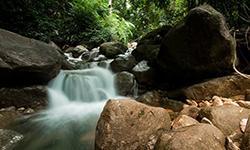
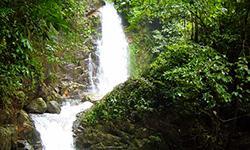
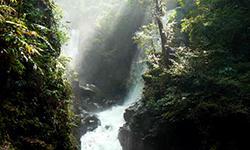
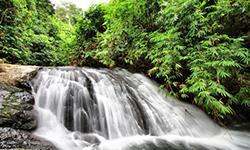
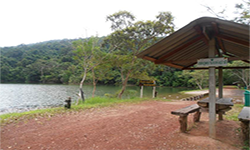
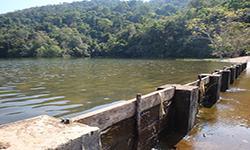 ฃ
ฃ